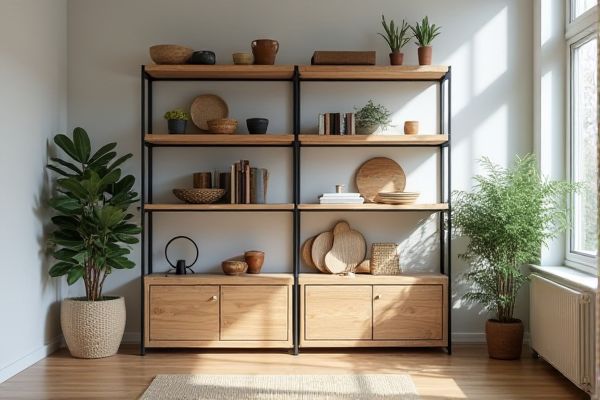
Metal shelving offers superior durability and weight capacity, making it ideal for heavy-duty storage, while wooden shelving provides a warm aesthetic and versatility for lighter, decorative use. Discover which option best suits Your space and needs by exploring the full comparison in this article.
Table of Comparison
| Feature | Metal Shelving | Wooden Shelving |
|---|---|---|
| Durability | Highly durable, resistant to warping and moisture | Moderate durability, prone to warping and damage from moisture |
| Weight Capacity | Supports heavy loads, ideal for industrial use | Supports moderate loads, best for light to medium use |
| Maintenance | Low maintenance, easy to clean | Requires regular maintenance and treatment |
| Appearance | Modern, industrial look | Classic, warm aesthetic |
| Cost | Generally more affordable and long-lasting | Typically more expensive with potential replacement costs |
| Environmental Impact | Recyclable, often made from recycled materials | Biodegradable, renewable resource but may involve deforestation |
| Installation | Quick assembly, often modular | May require custom fitting and tools |
Introduction to Metal vs Wooden Shelving
Metal shelving offers superior durability and load-bearing capacity ideal for industrial and commercial environments, while wooden shelving provides aesthetic warmth and versatility suited for residential and decorative purposes. Metal shelves resist moisture, pests, and wear, ensuring longevity with minimal maintenance. Wooden shelves, available in various finishes and styles, add natural beauty but may require periodic upkeep to prevent damage from humidity or physical impacts.
Material Composition and Durability
Metal shelving, typically made from steel or aluminum, offers superior durability and resistance to warping, moisture, and pests compared to wooden shelving composed of hardwood or plywood. The corrosion-resistant coatings on metal shelves enhance their lifespan in industrial and high-humidity environments, while wooden shelves can degrade more quickly and require regular maintenance. Metal's structural integrity supports heavier loads, making it ideal for heavy-duty storage, whereas wooden shelving is often preferred for aesthetic appeal but is less robust under stress.
Aesthetic Appeal and Design Flexibility
Metal shelving offers a sleek, modern aesthetic with clean lines and a variety of finishes, making it ideal for contemporary or industrial-style spaces. Wooden shelving provides warm, natural textures and can be customized with stains, paints, or carvings to complement traditional or rustic decor. Your choice depends on whether you prioritize the durability and minimalist look of metal or the timeless, versatile charm of wood for your interior design.
Load Capacity and Weight Support
Metal shelving offers superior load capacity and weight support compared to wooden shelving, making it ideal for heavy-duty storage needs in warehouses or garages. Steel construction typically supports hundreds of pounds per shelf, while wooden shelving may warp or weaken under similar loads over time. You should consider metal shelving if durability and consistent strength are critical for your storage requirements.
Installation and Assembly Differences
Metal shelving typically features a modular design with pre-drilled holes, allowing for quick, boltless assembly that requires minimal tools, often just a rubber mallet or screwdriver. Wooden shelving usually demands more precise measurements, cutting, and fastening with screws or nails, leading to longer installation times and the need for additional tools like drills and saws. The durability and weight of metal components facilitate easier adjustments and scalability compared to heavier, more rigid wooden shelves.
Maintenance and Cleaning Requirements
Metal shelving offers low maintenance with easy cleaning using damp cloths and mild detergents, making it ideal for environments prone to moisture or spills. Wooden shelving demands more care to prevent damage from moisture, requiring occasional polishing and protection from scratches or stains to maintain its appearance. Your choice should consider the ease of upkeep based on the specific demands of your storage space.
Cost Comparison: Metal vs Wooden Shelving
Metal shelving generally offers a lower initial cost and higher durability compared to wooden shelving, especially for industrial and heavy-duty storage needs. Wooden shelving can be more expensive upfront due to material and craftsmanship but often provides a more aesthetic and customizable option for residential or decorative purposes. Over time, metal shelving incurs lower maintenance costs because it resists warping, pests, and moisture damage better than wood.
Suitability for Different Environments
Metal shelving excels in industrial and high-moisture environments due to its durability, resistance to rust, and ability to support heavy loads, making it ideal for warehouses, garages, and basements. Wooden shelving offers a warmer aesthetic and is better suited for dry, indoor spaces such as living rooms, offices, and retail displays, where moderate weight support and style are priorities. Each material's environmental suitability significantly impacts longevity, maintenance needs, and functional performance, with metal shelving favoring robustness and wood emphasizing design and ambiance.
Longevity and Environmental Impact
Metal shelving offers superior longevity due to its resistance to warping, pests, and moisture damage, making it ideal for long-term storage solutions. Wooden shelving, while biodegradable and often sourced from sustainable forests, tends to degrade faster and may require more frequent replacement. Environmentally, metal shelving has a higher initial carbon footprint but benefits from recyclability, whereas wooden shelving has a lower production impact but contributes to deforestation if not responsibly harvested.
Choosing the Best Shelving for Your Needs
Metal shelving offers superior durability and strength, ideal for heavy-duty storage and industrial environments, while wooden shelving provides a warmer aesthetic and better customization options for home or office use. Your choice depends on factors such as load capacity, environmental conditions, and design preferences, with metal excelling in moisture resistance and longevity, whereas wood appeals with its natural look and ease of modification. Evaluate your storage needs, space constraints, and budget to determine whether metal's robustness or wood's versatility best suits your organization goals.
 homyna.com
homyna.com